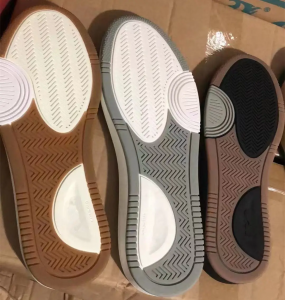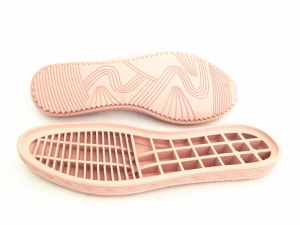Are you a sneaker buyer looking to learn more about the materials and technologies used in your favorite shoes? Or do you work in the shoe industry and want to expand your knowledge? Whatever your background, this blog post is for you. In this article, we’ll take an in-depth look at the different components of a sneaker, including the outsole, midsole, insole, and unibody.
1. Outsole
1. The material of the outsole is simply natural rubber or synthetic rubber.
(1) Natural rubber: The advantage of natural rubber is that it is very soft and elastic, suitable for various sports, but the disadvantage is also obvious, that is, it is not wear-resistant. Indoor sports shoes mostly use natural rubber.
2. Synthetic rubber is divided into wear-resistant rubber, environmentally friendly rubber, air rubber, viscous rubber, hard rubber, carbon-added rubber, etc.
(1) Wear-resistant rubber: Wear-resistant rubber has very good wear resistance and toughness, so it is very durable. This rubber material is commonly used on the outsoles of tennis shoes.
(2) Environmentally friendly rubber: also known as recycled rubber, this rubber outsole contains up to 10% recycled rubber, and its main purpose is to protect the environment.
(3) Air rubber: The rubber contains air, which has a certain shock absorption function, but it is not very wear-resistant, and its use is not very wide.
(4) Sticky rubber: Sticky rubber is characterized by good flexibility and very non-slip, and is generally used for indoor sports shoes.
(5) Hard rubber: Hard rubber is the most comprehensive rubber in the outsole rubber material. It’s tough, non-slip, and wear-resistant, so it’s versatile. Multi-purpose shoes and basketball shoes mostly use this rubber as the outsole.
(6) Carbon-added rubber: carbon is added to ordinary rubber materials to make the rubber more tough and wear-resistant. Most running shoes are made of this rubber, and the letters BRS are left on the back of the sole of the running shoe. Indicates that the outsole is made of carbon-added rubber.
3. Glue outsole: This kind of outsole is not common. The raw material of this bottom is industrial glue, which is stirred by a mixer and put into a mold for heating and forming. It is characterized by being soft and very non-slip.
2. Midsole
1. Now I think many people will not know the midsole of sports shoes, that is the PHYLON midsole, and the EVA midsole is the most common. In fact, these two midsoles belong to the same attribute category (engineering plastics), but why are they called differently? PHYLON originated in the United States. The earliest midsole shoes were called PHYLON. At that time, there was no EVA midsole and PHYLON midsole. Later, with the continuous development of footwear products, some big brand footwear R&D factories in Taiwan and South Korea were used as the source, and the name of the midsole was also divided more systematically, so we have what we are talking about now. EVA midsole. Next, let me talk about the difference between the EVA midsole and the PHYLON midsole.
The midsole most used in shoes now is the PHYLON midsole. The biggest feature of PHYLON is light, good elasticity and good cushioning performance. The full name of PHYLON is secondary foaming. EVA midsole is also very light, but the cushioning performance and elasticity are far inferior to PHYLON midsole, and the cost is much lower than PHYLON. The EVA midsole is called primary foaming. The reason why they have the same performance, but different names and different performances is that PHYLON is secondary foaming, while EVA is primary foaming.
(1) Primary foaming: The shoe midsole formed by injecting the material into the mold and heating at a high temperature is called the primary foaming midsole, that is, the EVA shoe midsole.
(2) Secondary foaming: After the material is injected into the mold, it is heated twice at high temperature, and the midsole of the shoe is fired and formed, which is called the secondary foaming midsole, which is what we often call PHYLON midsole. PHYLON hardness is also controlled by temperature. In the process of firing PHYLON midsole, the higher the temperature, the denser and harder the fired PHYLON is. The lower the heat, the lighter and softer the naturally burning PHYLON, so the quality of the midsole of the shoe cannot be measured by weight or hardness.
(3) Wrapped midsole: The wrapped midsole is also a PHYLON midsole, but it is just a shoemaking technique adopted by designers in order to pursue the overall design sense. The best example of this is the midsole and body of a shoe. The same fabric is used to make the overall combination of the shoe body and the sole, which is also a highlight of the craftsmanship of this shoe. To achieve this process is to wrap the formed PHYLON midsole with the selected fabric, and fire it at high temperature in the mold to become a cloth midsole like the LB1 we saw.
2. PU midsole: In addition to PHYLON midsole and EVA midsole, PU midsole is also very common. The biggest advantage of PU midsole is its good elasticity and toughness.
3. Filled midsole: Many sports shoes now use a built-in midsole structure, also called a filled midsole. Like the familiar T-MAC series, NIKE’s style series all belong to the midsole structure of the bag. The midsole of the bag is composed of two parts, the outsole and the upper, but the structure is still the outsole, the midsole and the shoe. The upper is made up of three parts, but the midsole wraps around the inside of the upper.
3. Insoles and overall soles
1. Insole: The insole can also be made of acid as a form of midsole. Unlike the midsole of the bag, the structure of the midsole is that the bottom is wrapped in the outsole of the shoe. For example, FORCE1, even the midsole structure is not like the overall rubber outsole seen from the outside. In fact, the inside of the rubber outsole is covered with a midsole. This kind of midsole is also called MD midsole, which is a kind of EVA foaming at one time.
2. Integral sole:
(1) The most common single-piece sole is EVA single-time foam molding sole. This kind of sole is low cost and has poor slip resistance. After the sole is stained with water, it is like wearing roller skates. REEBOK’s 3D sole is the best “spokesperson” for this EVA disposable foam sole.
(2) PU overall sole: ADI and NIKE do not use this kind of sole very much, and PU sole is a low-temperature forming sole. The characteristic of PU bottom is that it is light, but it is not suitable for wetting. After encountering water, a chemical reaction will occur and it will be corroded layer by layer.
(3) Pure rubber soles: pure rubber soles are mostly used for outdoor hiking shoes, or work shoes, electric shoes. The entire sole is entirely made of rubber, which has the advantage of being wear-resistant and non-slip, and the disadvantage of being too heavy. CAT work shoes generally use this sole, also called insulating sole.
It is important to note that each material and technology has its own advantages and disadvantages, and the choice of material and technology will depend on the purpose and design of the shoe. At the end of the day, the most important thing is to find a pair of shoes that fit, provide the necessary support and cushioning, and feel good to wear. We hope this article was informative and helpful in your understanding of sneaker components. Keep exploring and learning more about your favorite shoes!




